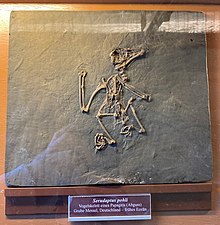| Halcyornithidae Temporal range:
| |
|---|---|

| |
| Cast of the holotype of Serudaptus, a halcyornithid, at the Natural History Museum of Vienna | |
| Scientific classification | |
| Domain: | Eukaryota |
| Kingdom: | Animalia |
| Phylum: | Chordata |
| Class: | Aves |
| Clade: | Eufalconimorphae |
| Family: | †Halcyornithidae Harrison & Walker, 1972 |
| Genera | |
| |
| Synonyms | |
|
Pseudasturidae (Mayr, 2002) | |
Halcyornithidae is an extinct family of telluravian birds thought to be related to the Psittaciformes (parrots), Passeriformes (songbirds), and to the extinct Messelasturidae. Halcyornithids have been found in various Eocene formations in Europe and North America. Widespread and diverse in the Early Eocene of North America and Europe, halcyornithids are not found in locales later than the Middle Eocene. Halcyornithids were small, arboreal birds with zygodactyl feet, with two toes facing forwards and two facing back, a trait shared with other tree-dwelling families of Eocene birds like the Zygodactylidae and the messelasturids. The skull of halcyornithids features a ridge of bone above the eye called the supraorbital process, similar to birds of prey.[1][2] The relationships of the halcyornithids to other birds remain uncertain. Halcyornithids have been proposed as relatives to owls and as a lineage closer to parrots than to songbirds. Most recently, halcyornithids have been identified as the sister group of the clade including parrots and songbirds. It is also possible that Halcyornithidae is paraphyletic with respect to the Messelasturidae.[1]
- ^ a b Mayr, Gerald; Kitchener, Andrew C. (2023-07-17). "The Halcyornithidae from the early Eocene London Clay of Walton-on-the-Naze (Essex, UK): A species complex of Paleogene arboreal birds". Geobios. doi:10.1016/j.geobios.2023.06.003. ISSN 0016-6995. S2CID 259969084.
- ^ Mayr, Gerald (2022). Paleogene fossil birds. Fascinating life sciences (2nd ed.). Cham: Springer. ISBN 978-3-030-87644-9.
